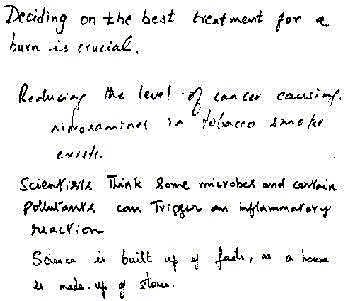Uniqueness of handwriting validated

Each person's writing is unique. This might be significant for court cases in which handwritten documents provide potentially relevant evidence.
COMPUTER SCIENTISTS at the University at Buffalo (UB) have provided the first peer-reviewed scientific validation that each person's handwriting is individual, according to a paper published in the Journal of Forensic Sciences.
The results of the UB research could be significant for other court cases in which handwritten documents provide potentially relevant evidence.
Efforts to analyse handwriting in criminal or civil cases have involved obtaining samples of writing from potential suspects or witnesses and then comparing them with the handwriting in question.
But several Supreme Court decisionsincluding testimony about document examination, must meet scientifically rigorous criteria. Because few, if any, objective criteria have existed for handwriting analysis, testimony concerning handwritten documents often has not been admitted in testimony.
The UB research is the first to provide such objective criteria.
"We set out to answer on a scientific basis the question, `is the handwriting of different individuals truly distinct?'
The answer is `Yes,' said Sargur Srihari, Distinguished Professor in the UB Department of Computer Science and Engineering, and director of the Centre of Excellence in Document Analysis and Recognition (CEDAR) at UB.
That expertise in teaching machines to read handwritten letters and numbers attracted the attention of the National Institute of Justice, which was interested in a different problem: finding out not what a written document said, but rather the identity of the writer.
The UB team developed a software system, based on an analysis that identified features from each of 1,500 handwriting samples and assigned a value to each feature.
Based on those values, the system is able to distinguish with 96 per cent confidence whether two documents were written by the same person or different people.
Srihari added that the team's ability to answer the question with such a high confidence rate implies that there is a significant amount of variation between the handwriting of individuals.
The UB researchers solicited cursive handwriting samples of the same three documents from 1,500 individuals representative of the distribution of different genders, age groups and ethnicities in the general population.
The source documents were designed to capture a wide range of attributes of handwritten English, such as variations in the positions of letters, numbers and punctuation marks, and certain combinations of letters and numbers.
The Arizona researchers extracted features relevant to the entire document, to specific paragraphs in the document, to single words of the document and even single characters.
Instead of analysing the documents visually, the way a normal human expert would, Srihari said their software system deconstructed each sample. The system extracted about 11 features. These characterise the overall structure of the writing.
The structures include the layout of the document and spacing of each line. It also includes about 512 features of individual characters, such as individual stroke marks and how the openings and closures of each character are made.

